
When it comes to audio technology, electret condenser microphones (ECMs) represent a classic yet robust solution for sound capture, delivering reliability and adaptability across a wide spectrum of applications. While MEMS microphones have gained prominence due to their integration-friendly design and compact footprints, ECMs maintain relevance in electronic designs, thanks to their diverse mounting configurations, wide-ranging directional patterns, and acoustic versatility.
This article will examine the operational principles of ECMs, exploring their internal circuitry as well as directional response, from omnidirectional patterns for broad ambient sound capture to unidirectional configurations for focused sound isolation.
Critical performance metrics, such as sensitivity, signal-to-noise ratio (SNR), and frequency response, are also explored to guide proper component selection.
Electret Condenser Microphone Basics
Electret condenser microphones (ECMs), also known as capacitor microphones, operate using an electret—a ferroelectric material that is permanently electrically charged or polarized. The electret’s high electrical resistance and chemical stability ensure that the embedded charge remains intact for hundreds of years without significant decay.
The term “electret” originates from the combination of “electrostatic” and “magnet,” reflecting the process by which a static charge is embedded in the material. This is achieved by aligning the static charges in the electret, analogous to the way magnetic domains are aligned to create a magnet.
This inherent property offers a significant advantage in microphone design. Unlike traditional condenser microphones, which require an external polarizing voltage to operate, the built-in static charge of the electret eliminates this need.
This simplification reduces complexity in circuit design and enables ECMs to function efficiently in compact and low-power applications, making them an attractive choice for a variety of audio systems.
The working principle of an electret condenser microphone relies on the diaphragm functioning as one plate of a capacitor, with the backplate serving as the other. When sound waves cause the diaphragm to vibrate, the distance between the diaphragm and the backplate changes, leading to variations in capacitance.
These changes are governed by the capacitance equation:
C = Q / V
Where:
- Q = charge in coulombs (remains constant due to the electret’s embedded charge)
- C = capacitance in farads
- V = potential difference in volts
As the capacitance (C) changes due to diaphragm movement, there is an inversely proportional variance in the voltage (V) across the capacitor, generating an electrical signal that corresponds to the sound vibrations.
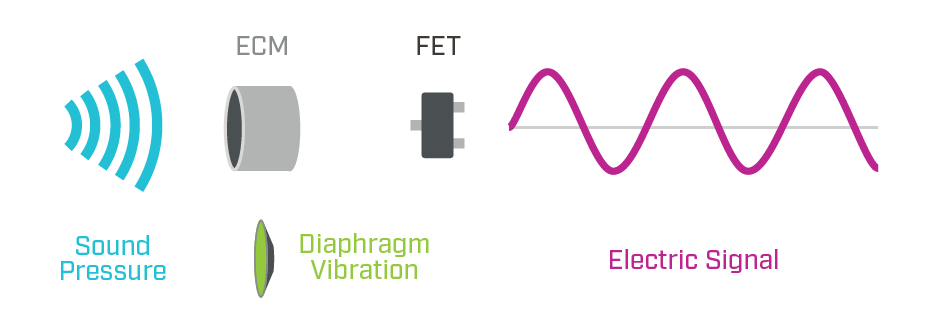
This varying voltage is then fed to a field-effect transistor (FET) within the microphone, which amplifies the signal for better transmission.
A DC-blocking capacitor at the output stage removes any unwanted DC offset, ensuring that the output is a clean audio signal. This straightforward yet effective design makes ECMs a reliable choice for capturing sound in various electronic applications.
The typical structure of an electret condenser microphone includes several key components:
- Non-woven cloth: Protects against dust while allowing sound to pass
- Case: Encases and protects internal parts
- Polar ring: Highlights the electret material applied to the diaphragm
- Diaphragm: Vibrates in response to sound, altering capacitance
- Spacer: Maintains the diaphragm-backplate distance
- Back plate: Forms the stationary electrode of the capacitor
- Base: Provides structural support
- Copper ring: Ensures conductivity and electrical connections
- PCB: Houses the FET and other circuitry for signal amplification
The disassembled and assembled structure of an ECM are illustrated in the figures below.
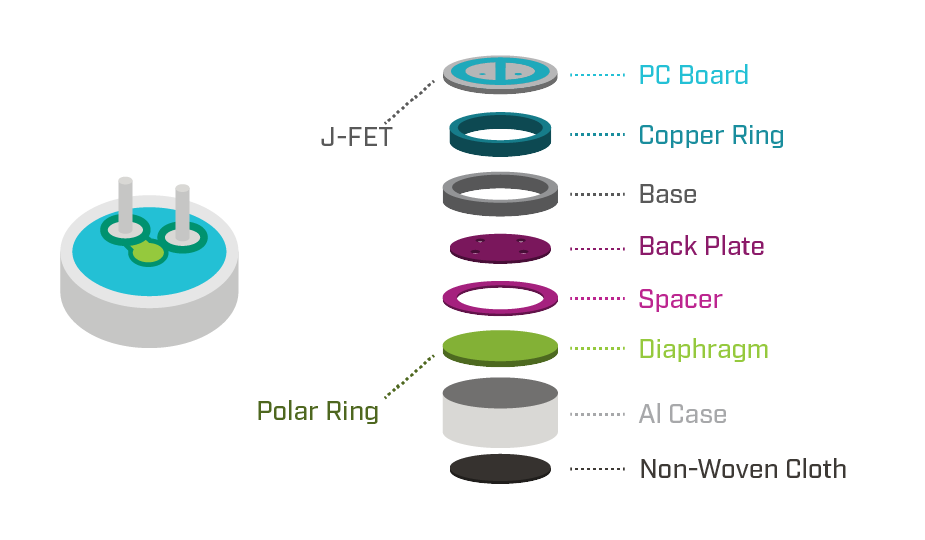
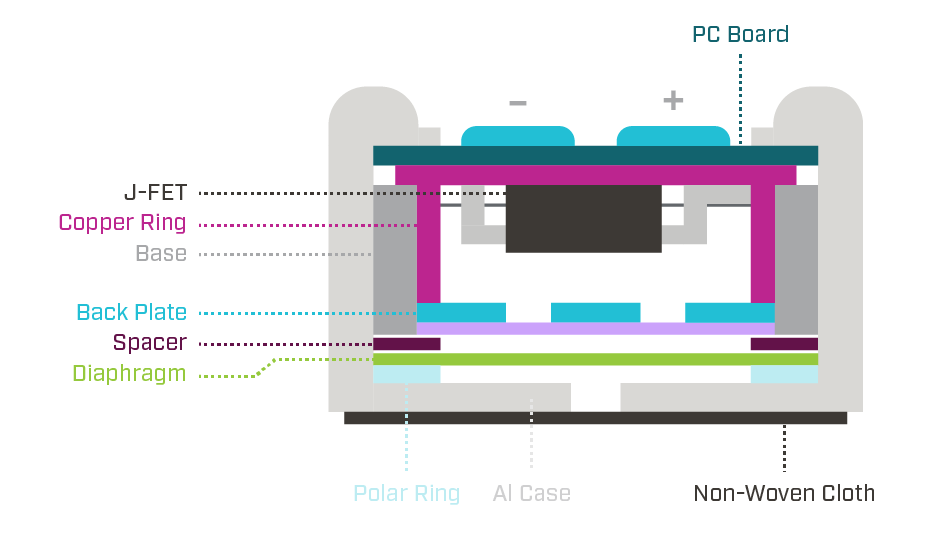
ECM Directionality or Polar Patterns
Electret condenser microphones are available in various directional or polar patterns, defining how they capture sound from different directions. Directionality is a critical specification and should be chosen based on the application and usage requirements.
The most common ECM directional patterns are omnidirectional (Figure 4), unidirectional (Figure 5), and noise-cancelling (Figure 6).
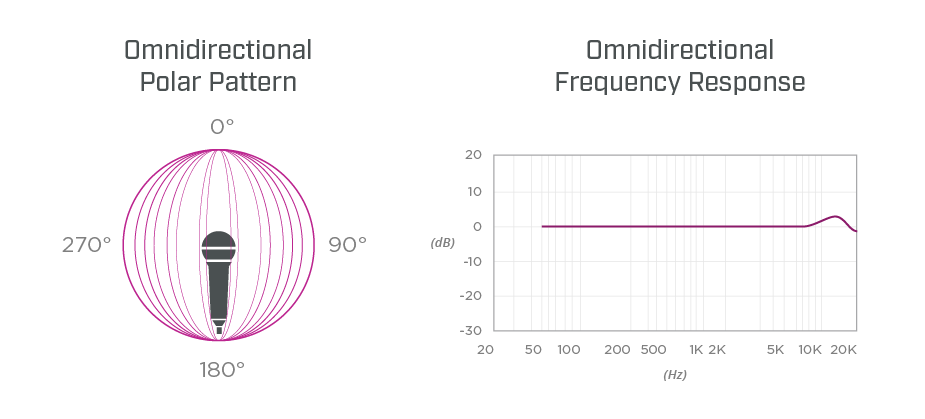
Omnidirectional microphones capture sound from all directions, making them ideal for applications like recording groups of vocalists or conducting conference calls. The sound pickup pattern is typically illustrated in a diagram, with 0° representing the front of the microphone and sound intensity plotted radially from 0° to 360°.
While versatile, these microphones have a drawback: they cannot distinguish between desired sounds and ambient noise, often picking up and amplifying environmental sounds.
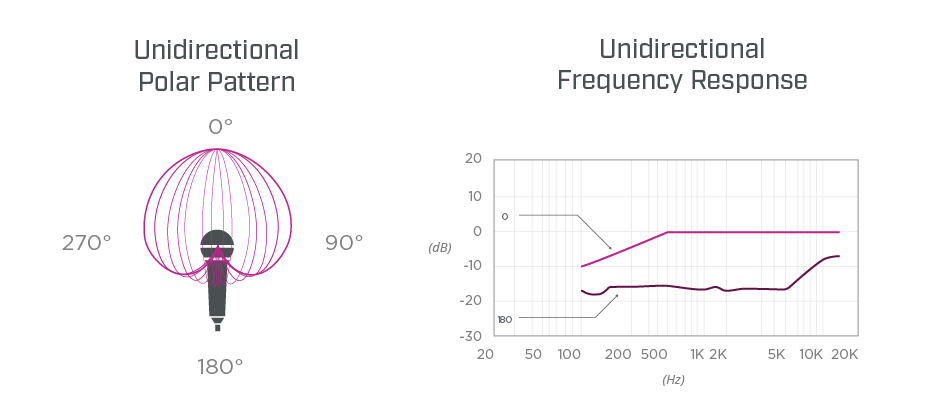
Unidirectional microphones are designed to capture sound primarily from one direction, reducing unwanted background noise like talking, keyboard clicks, or paper rustling.
This makes them ideal for vocal or speech applications, where isolating the desired sound source is critical.
The most common unidirectional pattern, shown in Figure 5, features a wide pickup area with maximum rejection at 180° off-axis.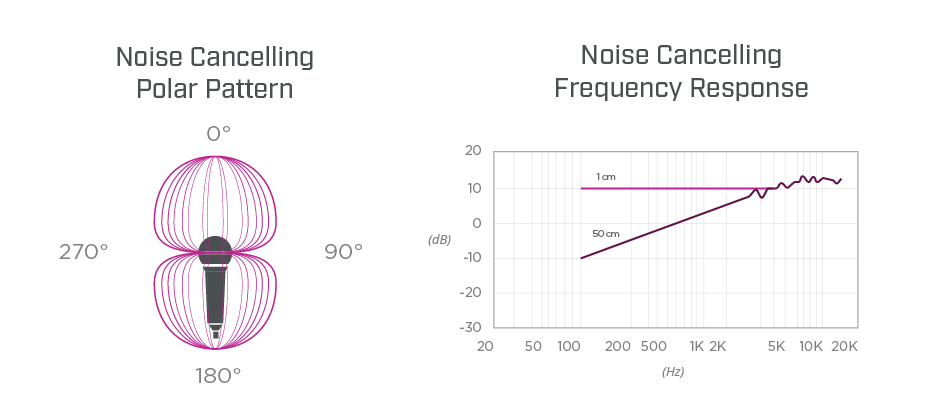
A noise-canceling microphone, or bidirectional microphone, is designed to filter out ambient noise while focusing on a desired sound source, making it ideal for noisy environments. These microphones feature at least two sound ports: one oriented toward the desired sound and another toward more distant noise.
Close sounds create a greater pressure gradient across the diaphragm, resulting in better capture of the intended audio. The proximity effect is adjusted to ensure a flat frequency response for sounds close to the front port, while sounds from other angles experience significant midrange and bass roll-off. Common applications include call centers, helicopter headsets, and race car driver communication systems.
Key ECM Specs
Outside of ECM directionality, here are a few additional parameters to keep in mind during component selection:
- Sensitivity Reduction: The loss of gain experienced when the microphone’s powering voltage decreases.
- Sensitivity: Measures how well a microphone detects sound. High sensitivity captures quieter or distant sounds with less amplification, reducing noise. This property helps determine suitability for applications like music recording or use in noisy environments.
- Signal-to-Noise Ratio (SNR): Represents the ratio of desired sound (e.g., speech or music) to background noise captured by the microphone, indicating overall audio clarity.
- Mounting Styles: PCB pin, wire leads with or without a connector, and terminal types are the most common configurations for ECM mounting. Terminal configurations can be further defined as surface mount for reflow solder or solder pads for hand soldering.
Conclusion
Electret condenser microphones remain indispensable in modern audio technology, offering precise sound capture and versatile directional capabilities. Their reliability and adaptability make them essential across diverse applications, while understanding their operation and key specifications helps users select the right microphone for their needs.
Explore Same Sky’s full range of microphones and audio design services for tailored solutions.
*All the opinions in this article are of Nick Grillone, Applications Engineer, Same Sky written for DigiKey India. The Volt Post takes no responsibility for the opinions, figures, and statistics mentioned in the column.*




